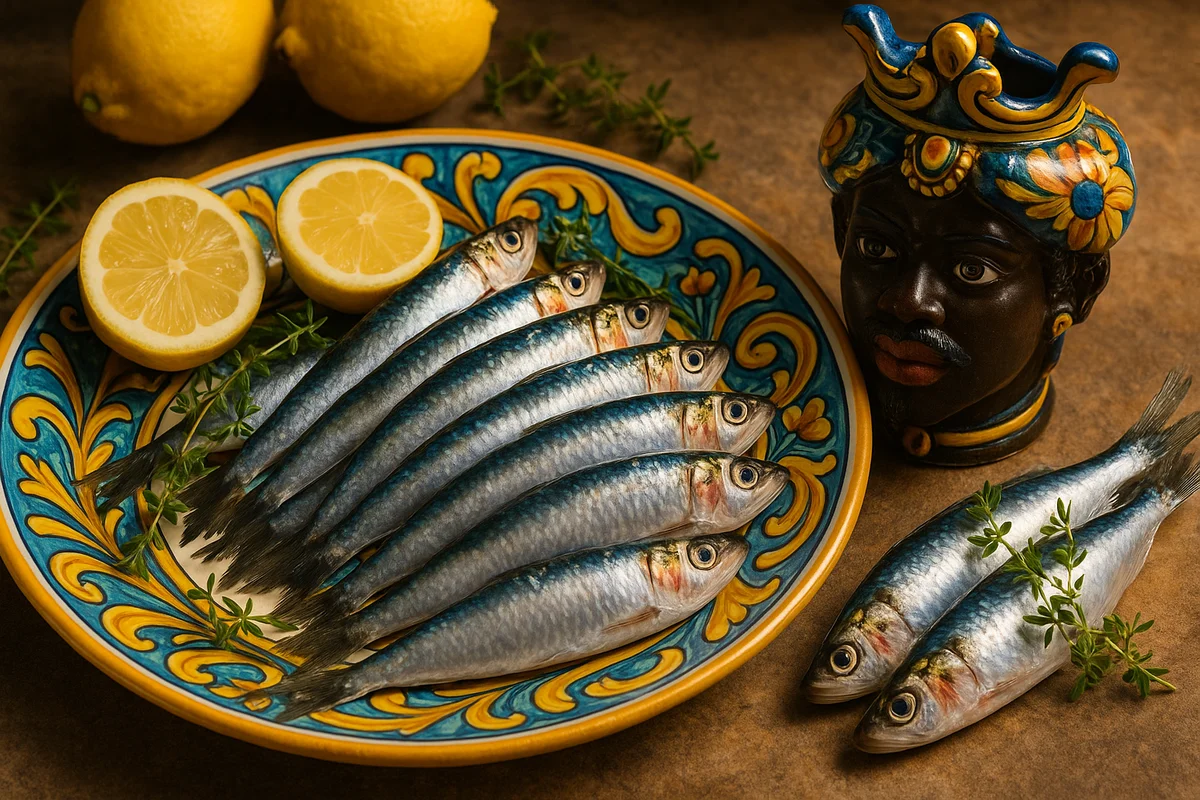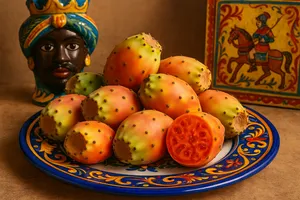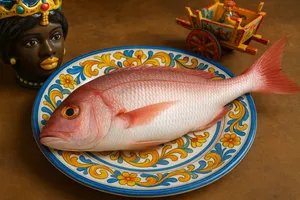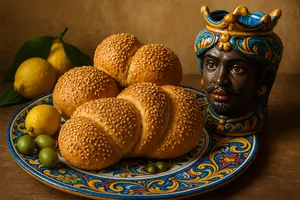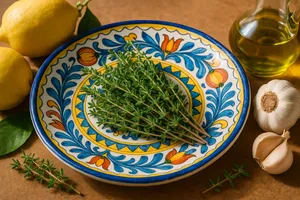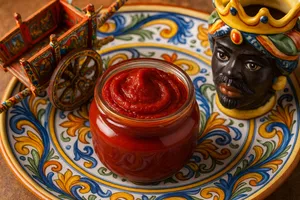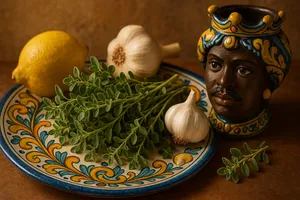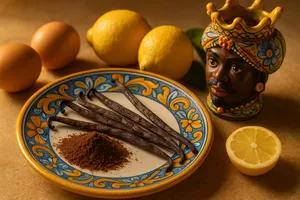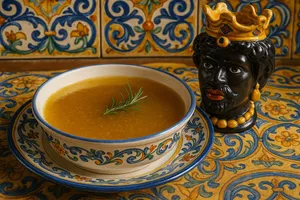Overview
Sardines are small marine fish belonging to the Clupeidae family (blue fish), with a slender, elongated body, blue-silver back and white belly, ranging from 10 to 25 cm in length. They swim in large shoals throughout the Mediterranean and are among the most fished and consumed species in Sicily, where they are a cornerstone of traditional cuisine and the foundation of iconic dishes that embody the soul of the island: pasta with sardines, sarde a beccafico, fried sardines, and gratinéed sardines. These preparations are not merely food but cultural heritage, expressing history, creativity and the culinary wisdom of Sicily.
The sardine fishery in Sicilian waters is a long-standing activity carried out with purse seine nets (lampare), which attract nocturnal shoals of blue fish. Freshly caught sardines have firm flesh, delicate flavour and a clean aroma of the sea. They are a “poor” fish in the sense of affordability, yet extraordinarily rich from both a nutritional and gastronomic standpoint. Sicilian cooks have elevated this humble fish, pairing it with noble ingredients—pine nuts, raisins, saffron, wild fennel—to create the island’s distinctive sweet-salty balance. Every Sicilian family has its own sardine recipes, every cook a personal secret to make them perfect. Sardines symbolise a generous sea, a living tradition, and a cuisine that honours simple ingredients with respect and imagination.
The word “sarda” may derive from Sardinia, where these fish were historically abundant and traded, although the etymology is uncertain. Sardines are closely related to pilchards (Sardina pilchardus) and anchovies (Engraulis encrasicolus), all blue fish with distinct characteristics.
Characteristics
Sardines have a streamlined, elongated body, laterally compressed, typically 15–20 cm long (up to 25 cm). Their back is metallic blue-green, their flanks bright silver, and their belly white. They have large, easily detachable scales, a central dorsal fin, pectoral fins and a forked tail.
The flesh is soft, fatty (rich in omega-3), and flavourful with the characteristic taste of blue fish. They contain many fine bones—central spine and lateral bones—that can be removed with patience or softened during cooking. Their flavour is more pronounced than that of white fish, appreciated by those who enjoy robust seafood.
Fresh sardines have bright, protruding eyes, red gills, firm glossy bodies and a clean marine scent. Poor-quality sardines have dull eyes, dark gills, limp bodies and an unpleasant smell. Freshness is essential.
Sardines vs sardina vs anchovies
These three blue fish are often confused:
Sardines (Sardina pilchardus): Medium-sized (15–20 cm), slightly stocky body, gill cover with characteristic radial striations. They are the largest of the three.
Sardines (pilchards): In fact “sardina” is synonymous with “sarda”—the same fish. Confusion arises because “sardina” is often used for smaller sardines or tinned sardines.
Anchovies (Engraulis encrasicolus): Smaller (10–15 cm), more elongated body, pointed snout, large mouth extending beyond the eye. Stronger flavour. Often preserved in salt.
In Sicily, sardines and anchovies are both used but for different dishes. Sardines are preferred for pasta with sardines and sarde a beccafico due to their size.
Fishing and seasonality
Sardines live in large shoals in coastal waters, moving with currents and plankton availability (their main food). They are fished with purse seine nets (lampare), trawls and set nets.
In Sicily, sardine fishing remains traditional though quantities have declined due to overfishing and environmental change. Fishermen know the seasons and zones where shoals are most abundant.
The best seasons are spring (March–May) and autumn (September–November). Summer sardines may be less fatty; winter catches are smaller. Spring sardines are especially prized, caught before spawning when quality peaks.
Cleaning sardines
Cleaning sardines requires care but is simple:
1. Rinse under running water.
2. Remove the head with a small knife.
3. Open the belly and remove the innards.
4. Rinse inside to remove blood and residue.
5. To fillet: open the sardine like a book, lay it skin-side down, press along the backbone to loosen it, then lift out the central spine with lateral bones attached. You obtain two fillets joined at the tail.
6. Rinse gently.
For some preparations (fried sardines), removing only head and innards is enough.
Use in Sicilian cuisine
Pasta with sardines
The quintessential Sicilian dish, a masterpiece of Palermo’s cuisine. Fresh (or salted) sardines, wild fennel, onion, pine nuts, raisins, saffron and pasta (bucatini) create a unique harmony of sweet-salty-aromatic flavours. A complex preparation symbolising Sicilian identity.
Sarde a beccafico
Filleted sardines rolled around a stuffing of breadcrumbs, pine nuts, raisins and herbs, arranged in a baking dish with bay leaves and baked. The name comes from the resemblance to beccafichi birds once cooked similarly. An elegant, celebratory dish.
Fried sardines
Whole sardines, cleaned, floured and fried in hot oil until crisp. The bones soften during cooking. Served hot with lemon—simple, delicious, popular in Sicilian fry shops.
Gratinéed sardines
Opened and filleted sardines topped with aromatic breadcrumbs (garlic, parsley, pecorino, pepper), drizzled with oil and baked or grilled until golden.
Grilled sardines
Whole sardines, cleaned and grilled over coals or on a griddle, dressed with oil, lemon and oregano. Grilling enhances their robust flavour.
Marinated sardines
Raw filleted sardines marinated in lemon, vinegar, garlic and parsley. The acidity “cooks” the flesh. Served cold as an antipasto.
Sardine meatballs
Chopped sardines mixed with breadcrumbs, eggs, cheese and herbs, formed into meatballs and fried. Ideal for using less-perfect sardines.
Pasta with sardines
This emblematic dish deserves special mention. Traditionally prepared for the feast of St Joseph (19 March), it features fresh sardines (some fried, others cooked in the sauce), boiled wild fennel, sautéed onion, toasted pine nuts, soaked raisins and saffron. Each family has its own variation.
The preparation is elaborate but yields extraordinary complexity: sweet (raisins), salty (sardines, pecorino), aromatic (fennel, saffron) and crunchy (pine nuts, toasted breadcrumbs) elements in perfect balance. It embodies centuries of history, cultural influences and culinary skill.
Sarde a beccafico
Another iconic dish: filleted sardines filled with toasted breadcrumbs mixed with oil, garlic, parsley, pecorino, pine nuts and raisins, rolled and arranged in a dish with bay leaves, sliced onion, oil and citrus juice. Baked until fragrant and glossy.
The name derives from aristocratic tradition: beccafichi birds were once cooked in this style. The people, unable to afford such delicacies, created a sardine version mimicking the shape. A perfect example of Sicilian ingenuity transforming humble ingredients into refined dishes.
Storage
Fresh sardines keep in the coldest part of the refrigerator, covered and on ice, for no more than 1–2 days. They must be eaten very fresh.
They freeze well: cleaned, layered between sheets of paper and sealed in bags or vacuum-packed, they keep for 2–3 months. Thaw slowly in the refrigerator.
Traditionally, sardines were preserved in salt (like anchovies) to ensure year-round availability. Salted sardines are used in some versions of pasta with sardines when fresh ones are scarce.
Buying tips
Check absolute freshness: bright, protruding eyes; red gills; firm, shiny body; fresh marine smell. Avoid dull eyes, dark gills, limp bodies or strong odours.
They should feel firm, not soft. The skin should be intact, glossy and brilliantly silver. Old sardines lose shine and appear matte.
Choose locally caught Sicilian sardines when possible for maximum freshness and to support traditional fisheries. Ask the fishmonger when they were caught.
Size matters: medium sardines (15–18 cm) are ideal for pasta with sardines and sarde a beccafico; small ones for frying; large ones for grilling.
Nutritional properties
Sardines are exceptionally nutritious: 100 g provide about 130–160 calories, 20–22 g of high-quality protein, 4–10 g of fats (mainly beneficial omega-3), and no carbohydrates.
They are rich in omega-3 fatty acids (EPA and DHA), with anti-inflammatory and cardioprotective properties. They provide vitamins D, B12, B3 and minerals such as calcium (especially when small softened bones are eaten), phosphorus, iron, selenium and iodine.
Highly recommended for health, sardines support cardiovascular function, cognition and overall wellbeing. Regular consumption of blue fish is associated with longevity in the Mediterranean diet.
Unlike large predatory species, sardines have low mercury levels (being small and low in the food chain), making them safe for frequent consumption.
Sardines in Sicilian tradition
Sardines have long been central to Sicilian diets. They were the people’s fish: affordable, nutritious and abundant. Families ate fresh sardines in season and salted ones the rest of the year.
Pasta with sardines was a festive dish for St Joseph’s Day, requiring time and precious ingredients such as pine nuts, raisins and saffron.
Sarde a beccafico were served on Sundays and special occasions, admired for their elegant presentation.
Street vendors once sold hot fried sardines from small carts—a coastal Sicilian tradition.
Curiosities
The expression “packed like sardines” comes from these fish’s habit of swimming tightly together in dense shoals.
Sardines swim in extraordinary synchrony, forming immense, coordinated shoals that move as if a single organism—an impressive natural spectacle.
In Sicily, pasta with sardines is considered so tied to the island that preparing it elsewhere is said to be nearly impossible: Sicilian wild fennel and local sardines are unrivalled. It is a dish deeply rooted in its territory.
A Sicilian proverb states: “Cu’ mancia sardi campa cent’anni” (“Who eats sardines lives a hundred years”), acknowledging their remarkable nutritional qualities.
Sardines were once preserved at home—salted, in oil or marinated—when plentiful, ensuring supplies for lean months. A wise domestic economy.
Night-time sardine fishing with lampare creates moving constellations of light on the dark sea—one of the island’s most poetic maritime traditions.
Sardines exemplify the concept of “poor food” that is, in reality, rich: inexpensive yet nutritious, flavourful and versatile. Sicilian cuisine has raised them to greatness.

